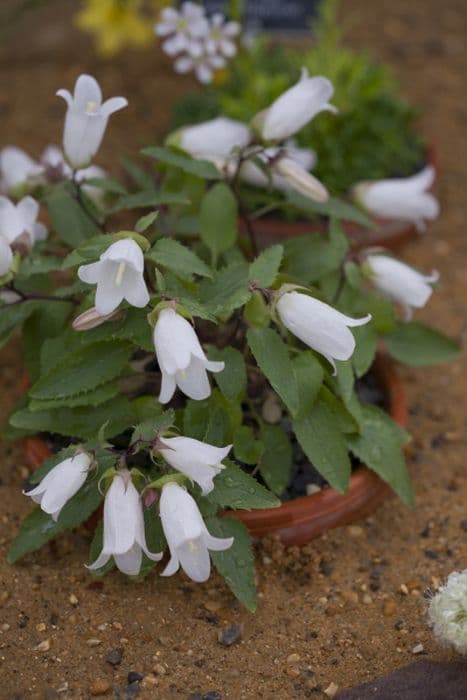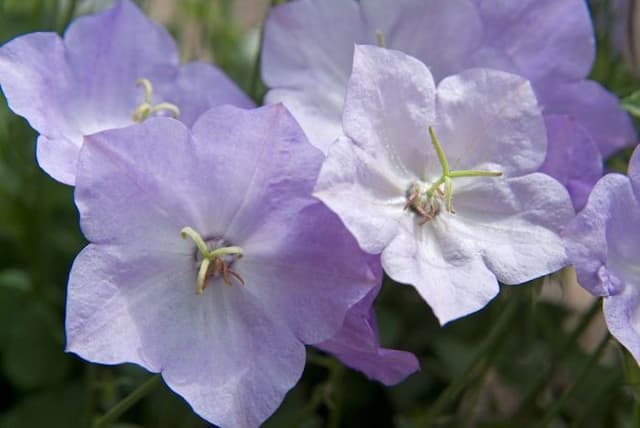Milky Bellflower Campanula lactiflora 'Alba'

ABOUT
Campanula lactiflora 'Alba', commonly known as the Milky Bellflower, is a perennial plant that exhibits a striking appearance. Its most notable feature is the clusters of bell-shaped, pure white flowers that bloom profusely and create a striking display against the backdrop of the plant's lush foliage. The flowers are gracefully arranged on branching stems which give the plant a delicate and elegant air, making it a favorite for gardeners looking to add a touch of serenity to their landscape. The leaves of the Milky Bellflower are bright green, with a lance-shaped to ovate form, providing a healthy and vigorous look to the plant. Their texture has a slightly roughened surface that contrasts subtly with the smooth opulence of the flowers. The overall shape of the plant is rounded, with the flower stems rising elegantly above the foliage, creating a layered effect that adds depth and interest to garden borders or flower beds. As a perennial, the Milky Bellflower returns year after year, building a mature clump that offers a more substantial presence in the garden over time. It blooms in the warmer months, during which time it can become a focal point in the garden due to the bountiful and captivating white flowers it produces. The white palette of its blooms also makes it an excellent candidate for moon gardens, where it can reflect the moonlight and create a luminous nighttime landscape. The Milky Bellflower gives off a romantic cottage garden feel and blends seamlessly with other plants in mixed borders. Its pure white flowers also make it a great choice for complementing plants with more vivid colors or acting as a foil to darker foliage. Its overall appearance evokes a sense of calm and beauty, making it a highly desirable choice for gardeners looking to create a serene and picturesque outdoor space.
About this plant
 Names
NamesFamily
Campanulaceae
Synonyms
Milky Bellflower, White Milky Bellflower, White Upright Bellflower
Common names
Campanula lactiflora.
 Toxicity
ToxicityTo humans
The Milky Bellflower (Campanula lactiflora 'Alba') is generally not considered toxic to humans. There are no well-documented cases of poisoning from ingesting this plant, and it's typically regarded as safe. However, it's always advisable to refrain from eating any part of ornamental plants unless they're known to be edible. Ingestion of garden plants can sometimes lead to gastrointestinal discomfort due to the presence of unusual compounds that humans aren't used to consuming.
To pets
The Milky Bellflower is also considered non-toxic to pets. While it isn't known for being poisonous, ingestion of plant material could potentially lead to mild gastrointestinal upset in some animals due to the novelty of the plant matter in their diet. Signs of such upset might include vomiting or diarrhea, but severe symptoms are not typically expected with this plant. Always monitor pets if they have ingested any plant material and consult a veterinarian if any concerning symptoms arise.
 Characteristics
CharacteristicsLife cycle
Perennials
Foliage type
Deciduous
Color of leaves
Green
Flower color
White
Height
4 feet [1.22 meters]
Spread
2 feet [0.61 meters]
Plant type
Herb
Hardiness zones
3
Native area
Caucasus
Benefits
 General Benefits
General Benefits- Aesthetic Appeal: Campanula lactiflora 'Alba', commonly known as the Milky Bellflower, offers a charming display of bright white, bell-shaped flowers that enhance the visual appeal of any garden.
- Pollinator Attraction: The nectar-rich flowers are attractive to bees, butterflies, and other pollinating insects, thus supporting local biodiversity.
- Low Maintenance: Once established, the Milky Bellflower is relatively low maintenance, requiring minimal care beyond watering and occasional feeding.
- Cottage Garden Style: Its traditional look is ideal for creating or enhancing a cottage garden aesthetic with its tall, upright growth habit and profuse flowering.
- Cut Flower Gardens: The long-lasting blooms and strong stems make it an excellent choice for inclusion in cut flower gardens, where they can be used in floral arrangements.
- Border Planting: The plant can serve as a delightful border for garden paths or as a backdrop for shorter plants, providing structure to garden landscapes.
- Seasonal Interest: Blooming typically in late spring to summer, it adds seasonal interest to garden beds and borders when many other perennials are not in peak display.
 Medical Properties
Medical PropertiesThis plant is not used for medical purposes.
 Air-purifying Qualities
Air-purifying QualitiesThis plant is not specifically known for air purifying qualities.
 Other Uses
Other Uses- Photographic subject: Due to its striking white blooms, the Milky Bellflower serves as a great subject for nature photographers, especially for those looking to capture the subtle diversity of a cottage garden.
- Artistic inspiration: The elegant form and color of the Milky Bellflower inspire artists and can be found depicted in watercolors, oil paintings, and botanical illustrations.
- Educational tool: Horticulture educators might use the Milky Bellflower to teach students about pollination, as it attracts bees and butterflies.
- Theme gardens: This plant can be used in moon gardens where all plants are white-flowered or silver-leaved, creating a luminous effect during twilight hours.
- Fairy gardens: Given its delicate flowers, the Milky Bellflower is ideal for creating whimsical fairy garden designs that appeal to children and fantasy garden enthusiasts.
- Wedding decor: Fresh or dried Milky Bellflower blooms can be incorporated into bridal bouquets, table centerpieces, or venue decorations for their natural elegance and pure color.
- Culinary garnish: Although not commonly used for consumption, the flowers can adorn cakes and desserts for special occasions, provided they are free of pesticides.
- Crafts: The dried flowers of the Milky Bellflower could be used in making potpourri or pressed flower crafts like bookmarks and greeting cards.
- Symbolism: In Victorian floriography, the Milky Bellflower can represent gratitude and everlasting love, making it a discreet token of affection when given as a gift.
- Dyeing fabric: Historically, some species of Campanula have been used in the natural dyeing process; Milky Bellflower's petals could potentially be explored for fabric dye.
Interesting Facts
 Feng Shui
Feng ShuiThe Milky Bellflower is not used in Feng Shui practice.
 Zodiac Sign Compitability
Zodiac Sign CompitabilityThe Milky Bellflower is not used in astrology practice.
 Plant Symbolism
Plant Symbolism- Constancy: The name "Campanula" is derived from the Latin word for bell, 'campana.' Bell flowers such as this often symbolize constancy and perennial love because they return each year with undiminished beauty.
- Gratitude: As with many flowers, the Campanula lactiflora 'Alba' can also symbolize gratitude, especially when given as a gift. Their delightful appearance is seen as a way of expressing thanks.
- Humility: The delicate, bell-shaped flowers that bow down as they bloom can represent humility, symbolizing a person's modesty or the act of being humble.
- Hope: The uplifting and resilient nature of the bellflower lends itself to the symbolization of hope, signifying the idea that positive outcomes are on the horizon.
 Water
WaterThe Milky Bellflower should be watered thoroughly, allowing the water to soak into the soil until it reaches the roots, without causing waterlogging. Typically, watering once a week should be sufficient, but this may vary depending on climate conditions and soil type. During hot or dry periods, additional watering may be required to keep the soil consistently moist. It's advisable to provide the plant with about 1 gallon of water per week, but always check the top inch of soil for dryness before watering again.
 Light
LightThe Milky Bellflower thrives in full sun to partial shade conditions. It performs best when provided with morning sunlight followed by light afternoon shade, especially in areas with hot summers. A spot that receives at least 6 hours of sunlight daily is ideal for this plant to flourish.
 Temperature
TemperatureThe Milky Bellflower can tolerate a range of temperatures but prefers a cooler climate. It can survive in temperatures as low as 20 degrees Fahrenheit and as high as 75 degrees Fahrenheit. However, the optimal growing temperature range is between 50 and 65 degrees Fahrenheit.
 Pruning
PruningPruning the Milky Bellflower is important to maintain shape, encourage bushier growth, and promote more abundant blooms. Pruning should be done in early spring or after the plant has finished flowering by cutting back about a third of the growth. Deadheading spent flowers can also encourage a second flush of blooms later in the season.
 Cleaning
CleaningAs needed
 Soil
SoilThe Milky Bellflower prefers a soil mix that is rich in organic matter and well-draining. A loamy soil with a pH ranging from 6.0 to 7.5 is ideal. Amend garden soil with compost and perlite to improve drainage and fertility.
 Repotting
RepottingMilky Bellflower should be repotted every 2-3 years to prevent it from becoming root-bound and to refresh the soil, giving the plant more space to grow and ensuring continued health.
 Humidity & Misting
Humidity & MistingMilky Bellflower thrives in moderate humidity levels but is adaptable and can tolerate the humidity found in most homes. No specific humidity requirements are necessary for this robust perennial.
 Suitable locations
Suitable locationsIndoor
Provide bright, indirect light and keep soil moderately moist.
Outdoor
Full sun to partial shade, shelter from strong winds, moist soil.
Hardiness zone
3-8 USDA
 Life cycle
Life cycleThe Milky Bellflower (Campanula lactiflora 'Alba') starts its life as a seed which, when sown, germinates usually within 2-4 weeks in warm, moist soil conditions. Once the seedling emerges, it develops a rosette of basal leaves during its first growing season, establishing a strong root system. In its second year, the plant begins to produce upright stems and a profusion of white, bell-shaped flowers during late spring or early summer, attracting pollinators such as bees and butterflies. After blooming, the flowers are followed by the production of seed capsules containing numerous small seeds. During the fall, the plant starts to die back naturally, retreating to dormancy over the winter months. Each spring, the Milky Bellflower resumes growth from its perennial rootstock, with the cycle of growth, flowering, seed production, and dormancy repeating annually.
 Propogation
PropogationPropogation time
Spring to Early Summer
The most popular method of propagation for the Milky Bellflower (Campanula lactiflora 'Alba') is by division, which is typically done in the spring or early fall. To propagate by division, remove the mature plant from the ground carefully and use a sharp knife or spade to divide the root ball into several sections, ensuring that each section has a healthy portion of roots and a few shoots. Replant the new sections at the same depth they were growing before and water them well to help establish the roots. It's important to maintain adequate moisture for the first few weeks until the new plants are well established. This method is favored due to its simplicity and effectiveness in creating new plants that are identical to the parent.









